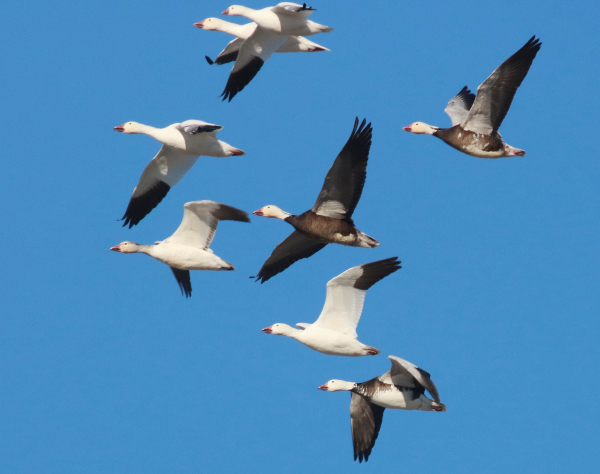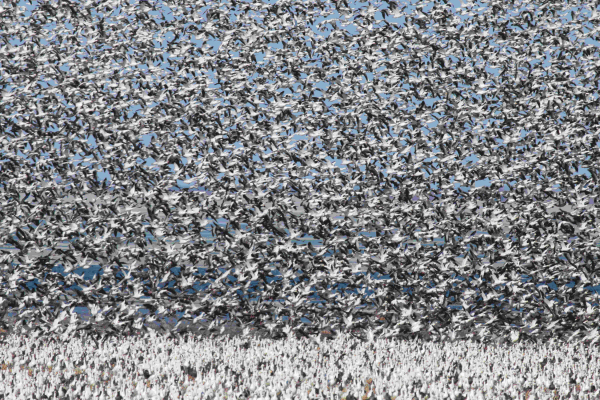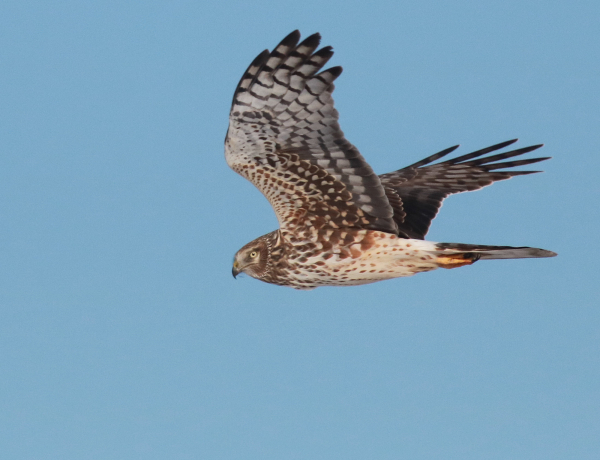
Snow Geese replaced White-fronts as the ultra-dominant species at Sand Lake Refuge last week. Note that the top bird in this flock is a smaller Ross’s Goose.

The huge concentrations of Snow Geese periodically erupted into a moving wall of geese. Imagine the size of this flock considering it measured a few more frames to the right and left of this photo.

Among the early migrants encountered closer to home was a female Northern Harrier. It’s an exciting time to monitor spring migration, while keeping safe in the process.
|
A few days certainly changed the birdscape at Sand Lake Refuge, which is now dominated by Snow Geese – numbering in the six figures a couple times over! Last Friday there were two distinct concentrations of Snow and Ross’s Geese that must have numbered more than 100,000 each, with many more undoubtedly on the way. There were also a couple thousand Canada Geese, much fewer Cackling Geese than the week before, and only a couple flocks of White-fronted Geese – a dramatic change!
Surprisingly, there were almost no geese beyond the refuge, so I still contend that this is the tip of the migration iceberg with remarkable numbers yet to come that will spread across hundreds of miles of the eastern Great Plains. But the sights and sounds of these first hundreds of thousands was amazing, and at times, they provided vivid surround sounds and sights. At one point, most of one of the two huge concentrations took flight – perhaps an eagle flew over – but they all but covered the sky and the sound they made resembled a stadium roar!
The Snows and Ross’s Geese settled back into the shallow, mostly frozen wetland expanse along the James River, lingering at this staging area later than the White-fronts and Cacklers did the week before. But when they left, they peeled away in huge flocks of about 1,000 and, sometimes, by 5,000 that erupted into the sky to fly to a common feeding area a few miles north.
I enjoyed the outing immensely, and never tire of being in the company of Arctic-nesting geese. They have always been special in many ways. When I reviewed my photos later that night, I was impressed with the much higher percentage of Ross’s Geese than I’ve ever noticed before. In the field I had the impression there were plenty of Ross’s in the mix, although it is so hard to distinguish white morph Snow Geese from the smaller Ross’s Geese. In flight though, especially when Ross’s are flocked together, they have a shallower wingbeat and they look smaller overall. Your best bet is to study photographs you take and pick out the Ross’s, whose smaller head and overall body size is most obvious in photos.
There were a few ducks on the edges of goose flocks, including Common Goldeneyes and Gadwalls, new among the Mallards, Northern Pintails, and Common Mergansers that were present last week. The standout among the ducks was a displaying flock of about two dozen goldeneyes with many males trying to impress each female as she surfaced from supposed feeding dives. Male after male called and threw its head back in the dramatic motion I wished I was close enough to photograph.
I also counted 19 Bald Eagles on the opposite side of the James River, including 6 in a big cottonwood tree, and 7 in another loose group perched on a couple low snags close to ground level and on the ice. Overall, there were definitely be more immature eagles in the mix than the week before. There will be many more eagles as the migration advances too; I’ve seen them number in the 90s during past springs.
Six days made a big change in the species composition and numbers – especially among the geese. And it’s interesting to note that beyond the refuge there were very few birds. Along the 75 mile drive I only counted 2 Red-tailed Hawks, 1 perched and 1 soaring, 2 lone Bald Eagles, a male Northern Harrier, a few widely scattered Western Meadowlarks, and maybe 4 lone male Red-winged Blackbirds perched in widely scattered small cattail stands. So obviously, for now, Sand Lake is the place to be for some exciting early season birding experiences. (I’ll keep you posted.)
Closer to Home
Sunday, while writing in my office, I spied a flock of about 70 Snow Geese out my window, flying south like every goose flock I’ve seen this far north this season. Perhaps it’s coincidence, but I always get the impression that flocks come up this far only to turn around during these earliest days of migration. Later Sunday afternoon I took a local drive that revealed a nice raptor migration, including 14 Red-tailed Hawks and 3 Bald Eagles scattered across the countryside. Instead of the one or two meadowlarks I’ve been seeing, Sunday’s Western Meadowlarks included several small flocks numbering from 5 to 10, another indicator of a little migration surge. Then I found a couple large flocks of Red-winged Blackbirds headed north, and another flock of Snow Geese flying southeast. As I walked to my doorway, I heard a robin call, and a moment later the first robin of spring flew by – Hooray!
Monday afternoon there were more signs of an increasing spring migration, primarily in the form of large flocks of 75 to 150 geese, including flocks of Snows and Ross’s, White-fronts, and Canadas – all flying southeast or south. But at after sunset the sounds of Giant Canada Geese filled the air just south of home, and a couple male robins sang sharply outside my door. Even Monday evening through midnight, I could hear flocks of Snow Geese flying overhead, seemingly pointed north this time. I’m sure the next 10 days will provide a lot of migration action in this region, and I hope you will enjoy the action in your area as spring progresses!
Article and photos by Paul Konrad
Share your bird sightings and photos at editorstbw2@gmail.com